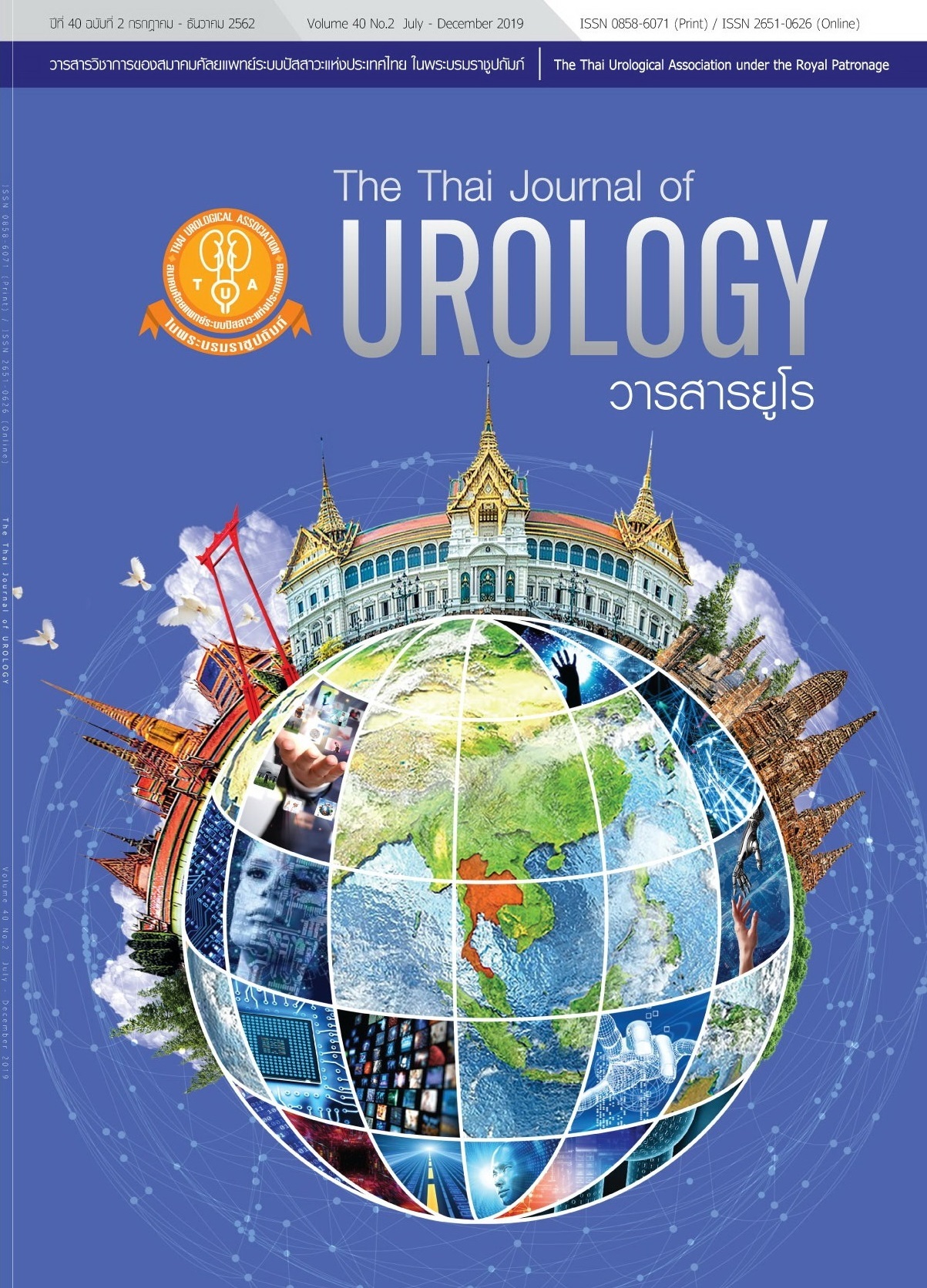Perioperative renal calculus factors affecting percutaneous nephrolithotomy outcomes
Keywords:
Percutaneous nephrolithotomy, renal calculus, stone free statusAbstract
Objective: Percutaneous nephrolithotomy has recently been the standard procedure for large kidney calculi. The aim of this study was to analyze the overall perioperative determinants of renal calculi that affect the results of percutaneous nephrolithotomy.
Materials and Methods: In a single tertiary hospital in Bangkok, Thailand, Ramathibodi Hospital, we performed a retrospective analysis of patients who underwent percutaneous nephrolithotomy from 2011 to 2018. The character of the kidney stones was determined using computed tomography. A statistical analysis was performed to determine the associations between kidney stone factors and stone-free status after surgery: operative time (OT), estimated blood loss (EBL), renal function, hospital stay, and postoperative complications.
Results: The comprehensive stone-free rate was 54.8%. Stone burden and stone density presented a statistically significant stone-free rate (p < 0.05). Only stone burden showed a correlation with postoperative blood loss and hospital stay.
Conclusions: Stone burden and density of renal calculi are crucial parameters for the prediction of stone-free status.
References
2. Ziemba JB, Matlaga BR. Epidemiology and economics of nephrolithiasis. Investig Clin Urol 2017;58:299-306.
3. Raheem OA, Khandwala YS, Sur RL, Ghani KR, Denstedt JD. Burden of Urolithiasis: Trends in Prevalence, Treatments, and Costs. European urology focus 2017;3:18-26.
4. Joual A, Fekak H, Rabii R, el Moussasoui A, Benjelloun S. [Complications of urinary calculi]. Ann Urol (Paris) 1996;30:251-6.
5. Chen Y, Feng J, Duan H, Yue Y, Zhang C, Deng T, et al. Percutaneous nephrolithotomy versus open surgery for surgical treatment of patients with staghorn stones: A systematic review and meta-analysis. PloS one 2019;14:
e0206810.
6. Turk C, Petrik A, Sarica K, Seitz C, Skolarikos A, Straub M, et al. EAU Guidelines on Interventional Treatment for Urolithiasis. European urology 2016;69:475-82.
7. Thomas K, Smith NC, Hegarty N, Glass JM. The Guy's stone score--grading the complexity of percutaneous nephrolithotomy procedures. Urology 2011;78:277-81.
8. Al-Kohlany KM, Shokeir AA, Mosbah A, Mohsen T, Shoma AM, Eraky I, et al. Treatment of complete staghorn stones: a prospective randomized comparison of open surgery versus percutaneous nephrolithotomy. The Journal of
urology 2005;173:469-73.
9. Soucy F, Ko R, Duvdevani M, Nott L, Denstedt JD, Razvi H. Percutaneous nephrolithotomy for staghorn calculi: a single center's experience over 15 years. Journal of endourology 2009;23:1669-73.
10. el-Nahas AR, Eraky I, Shokeir AA, Shoma AM, el-Assmy AM, el-Tabey NA, et al. Factors affecting stone-free rate and complications of percutaneous nephrolithotomy for treatment of staghorn stone. Urology 2012;79:1236-41.
11. Karalar M, Tuzel E, Keles I, Okur N, Sarici H, Ates M. Effects of Parenchymal Thickness and Stone Density Values on Percutaneous Nephrolithotomy Outcomes. Med Sci Monit 2016;22:4363-8.
12. Atmoko W, Birowo P, Rasyid N. Factors affecting stone free rate of primary percutaneous nephrolithotomy on staghorn calculi: a single center experience of 15 years. F1000Res 2016; 5:2106.
13. Hegarty NJ, Desai MM. Percutaneous nephrolithotomy requiring multiple tracts: comparison of morbidity with single-tract procedures. J Endourol 2006;20:753-60.
14. Sugihara T, Yasunaga H, Horiguchi H, Fujimura T, Nishimatsu H, Kume H, et al. Longer operative time is associated with higher risk of severe complications after percutaneous nephrolithotomy:analysis of 1511 cases from a Japanese
nationwide database. Int J Urol 2013;20:1193-8.
15. Anastasiadis A, Onal B, Modi P, Turna B, Duvdevani M, Timoney A, et al. Impact of stone density on outcomes in percutaneous nephrolithotomy (PCNL): an analysis of the clinical research office of the endourological society (CROES) pcnl global study database. Scand J Urol 2013;47:509-14.
16. Binbay M, Akman T, Ozgor F, Yazici O, Sari E, Erbin A, et al. Does pelvicaliceal system anatomy affect success of percutaneous nephrolithotomy? Urology 2011;78:733-7.
17. Mishra S, Sabnis RB, Desai MR. Percutaneous nephrolithotomy monotherapy for staghorn:paradigm shift for 'staghorn morphometry' based clinical classification. Curr Opin Urol 2012;22:148-53.
18. Khalil M, Sherif H, Mohey A, Omar R. Utility of the Guy’s Stone Score in predicting different aspects of percutaneous nephrolithotomy. African Journal of Urology 2018;24:191-6.
19. Lojanapiwat B, Rod-Ong P, Kitirattrakarn P, Chongruksut W. Guy’s Stone Score (GSS) Based on Intravenous Pyelogram (IVP) Findings Predicting Upper Pole Access Percutaneous Nephrolithotomy (PCNL) Outcomes. Advances in Urology 2016;2016:6.



